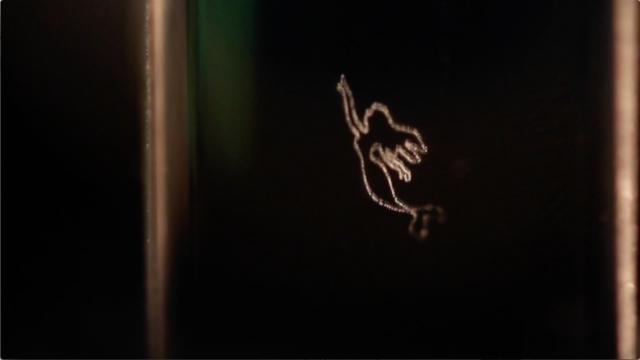Researchers really want to make good three-dimensional displays. It is so much harder than you might think — at this point, we have lots, but most attempts are literally smoke (light projected and scattered on some medium) and mirrors (optical illusions). There aren’t many examples of voxels, 3D pixels, lined up to create an image that you can walk around and see clearly from all sides.
Image: Kumugai et Al
One Japanese team has released an interesting but rudimentary proof-of-concept for their own so-called volumetric display, using lasers projected in a liquid column. Ultimately, the team hope to create an updatable 3D projection visible from all angles to put on display in a museum or aquarium.
“To develop a volumetric display of the kind we see in science fiction movies is a dream of we display researchers,” Kota Kumagai, researcher at the Center for Optical Research & Education (CORE) at Utsunomiya University in Japan, wrote in an email to Gizmodo. “I think it will take several years until we will be able to see as in sci-fi movie.”
And Kumagai really wants to create a working 3D display. He and his team came out with one prototype — a laser scattering off of a stack of fluorescent screens — back in 2015, for example.
His newest idea came after trying to build a screen based on a fluorescent liquid that can light up. Kumagai and his collaborators realised increasing the laser’s energy created bubbles in the fluid. Their new screen uses a column of viscous liquid, in this case glycerin, so the bubbles will stay in place and become voxels. An illuminating light shined onto these voxels scatters to become the image. The researchers used this method to create images of a mermaid, dolphin and rabbit in the liquid, and published their results in the journal Optica today.
When we say this display is a “proof of concept,” we mean it. The screen only creates small graphics, and though the team says they can do full-colour images, everything presented in the paper was single-colour. Plus, this display isn’t a video display — the produced image is stationary. An updatable version would require a stream of liquid to move or pop the bubbles. Essentially, it’d be like an updatable version of those 3D glass etchings you can buy in tourist gift shops, but with a vat of glycerin and lasers. There are a lot of better ways to make a stationary 3D image… like a sculpture.

Image: Kumagai et al
Why go through the trouble of creating a display like this when we have so many other ideas for 3D-screens? Well, every screen seems to have some drawback that makes it not truly volumetric, or sacrifices detail. This makes a lot of sense. How can you make a screen opaque enough so you can’t see behind a voxel, but transparent enough so that you can see through the screen? How do you stop a beam of light in a precise location, but change that location over the course of lots of frames, to make a movie?
Resulting images often have obviously visible voxels, and look like an image made from lots of dots. Others are only three dimensional from a certain viewing spot, like 3D televisions. There are bulky ones requiring lots of projectors or strange-shaped screens. Some are dim and use stacks of screens with a projector, like the thousand dollar Volume screen, or the screen Kumagai made back in 2015. Kumagai’s current screen is sort of a combination, voxels made with a laser for light to scatter off of. We’ve reached out to several scientists to see if there are any other drawbacks we should be aware of.
So, will microbubbles be the future of volumetric displays? Maybe! Based on the method that the screen needs to be refreshed, it will probably only be used for projecting single images, rather than video. But if Kumagai’s team finds a way to turn these illuinated vats of glycerine into high-definition images that can be updated with a stream of fluid, they might make an appearance in public spaces in the future. It’s certainly a wild idea.
[Optica]
